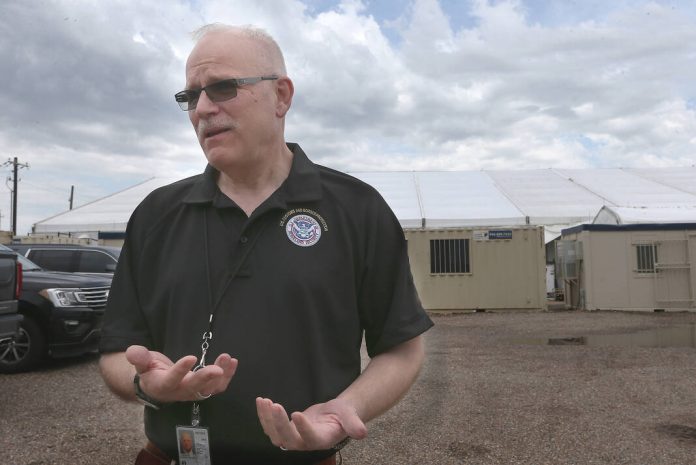
CBP Commissioner Chris Magnus speaks during an interview outside the Donna Processing Facility on Tuesday in Donna.
Delcia Lopez | [email protected]
|
Only have a minute? Listen instead
Getting your Trinity Audio player ready...
|
A jovial and optimistic commissioner for Customs and Border Protection visited the Valley this week to learn how partnerships with local leaders created infrastructure supporting fluctuating immigration traffic through an historic year.
Christopher Magnus, sworn into office in December 2021, looked invigorated as he spoke with CBP officers and reporters at the Donna processing tents Tuesday morning. He offered high-spirited greetings as he walked in a loose swagger conveying an ease not normally seen with other leaders from Washington like Department of Homeland Security Alejandro Mayorkas who spoke in a grave tone and a stiff posture during his last visit to the Valley.
“What I like the most about what I see here is the kind of nimbleness and ability to really build on relationships in a way that really makes me proud to be in the position I’m in,” Magnus said.
The commissioner held a muster with about 50 officers and a smaller one with about a dozen without any supervisors to hear concerns and learn how they manage growing challenges that may continue when a public health policy, known as Title 42, prepares to lift and allow immigrants to seek asylum instead of facing immediate expulsion.
Biden’s administration is facing sharp criticism from both sides of the political aisle over his immigration policies and practices. The Centers for Disease and Control, the department responsible for determining the need to keep Title 42 in place, decided to lift the policy in late May. Courts intervened and delayed it, but the public health policy is, by design, temporary and not an immigration policy.
“One of the things I discovered when I came on board at the beginning of the year was how much planning had already been underway for many months,” Magnus said. “We know that it will end at some point.”
Last month, the Department of Homeland Security shared an overview of their preparedness plan for addressing the challenges of lifting Title 42 which will allow immigrants to seek asylum once again, a right protected by asylum law. But federal, state and local leaders have expressed concern over its end.
“I fear, though, that we’re about to experience an immigration surge like we’ve never experienced before,” Javier Villalobos, McAllen mayor, said in a social media video posted on April 6.
Hidalgo County Judge Richard F. Cortez expressed concern over the coming change.
“We need to have some idea about what our capacity is to manage the asylum seeking immigrants,” the judge said Wednesday.
Cortez met with Magnus at the Catholic Charities of the Rio Grande Valley’s respite center in McAllen on Tuesday where they were joined by its executive director, Sister Norma Pimentel. Magnus toured the largest shelter in South Texas that became overwhelmed last summer when thousands of migrants were released from federal custody in July which prompted emergency action from the county.
The meeting lasted about an hour and a half, a long time compared to the quick tours typically taken by Capitol Hill visitors.
Washington continues to face pressure on their handling of immigration affecting border communities, but Magnus came to take notes on how the busiest sector handles large crowds.
“There’s no place where we can address these challenges without the role of local government as a key player. Whether it’s big or small. Local government has a key role,” Magnus said.
Other communities faced a shift in immigration patterns, like Del Rio. Unlike the Valley, there was no infrastructure and resources were severely lacking.
“We still know that whether it’s a smaller community or a larger community that has more resources, there’s some common themes, there’s common denominators that you have to have. One of them is a community-wide commitment to addressing the problem,” Magnus said, praising the collaboration he witnessed in the Valley.
The lack of preparation in Del Rio left hundreds of migrants in poor holding conditions. Magnus is committed to improving their strategizing, however.
“CBP and Border Patrol are such learning organizations. We learn from when we make mistakes, and we can admit when we don’t handle something well,” the commissioner said. “So, we try to figure out, okay, what’s our take-away from this? What do we do differently? How can we share that within the organization to maximize our ability for success?”
Cortez felt the trip provided some insight. “He felt we were very good at partnering together to help one another. He felt that was a strength. And, I agree with him,” the judge said.
Magnus came with one central question on his mind: “How can we take a lot of the things that are working here and apply them elsewhere?”
In spite of the criticism that piles on, the commissioner held a different disposition.
“My confidence is high,” he assured as he pressed forward on his mission.



